5 Natural Materials Used As Construction Materials
Rock
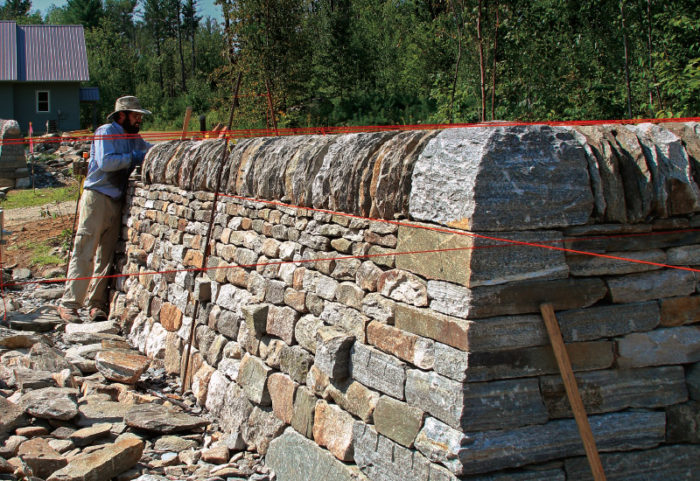 Thinking about building a house, immediately most people will think of square bricks or precast concrete blocks that are convenient and widely used. However, if you take advantage of the available stones locally, you can completely build yourself a unique, lovely home, moreover, it saves a lot of costs.
The stone wall can absorb heat well; this means that, when the weather outside is hot, it will absorb this amount of heat and keep the indoor air more pleasant than outside; conversely, in the winter, it uses the same heat-absorbing mechanism to absorb heat from the outside and "heat" it for a warm interior. Truly convenient right?
This type of material is suitable for use in desert areas where there is a huge difference in temperature between day and night. If used appropriately, it will be an economical solution for air conditioning because the house can be heated or cooled without the need for a heater or air conditioner. It helps reduce the amount of energy used for heating / cooling in the home. So if you are thinking to build a new house, stone wall could be your next option.
Thinking about building a house, immediately most people will think of square bricks or precast concrete blocks that are convenient and widely used. However, if you take advantage of the available stones locally, you can completely build yourself a unique, lovely home, moreover, it saves a lot of costs.
The stone wall can absorb heat well; this means that, when the weather outside is hot, it will absorb this amount of heat and keep the indoor air more pleasant than outside; conversely, in the winter, it uses the same heat-absorbing mechanism to absorb heat from the outside and "heat" it for a warm interior. Truly convenient right?
This type of material is suitable for use in desert areas where there is a huge difference in temperature between day and night. If used appropriately, it will be an economical solution for air conditioning because the house can be heated or cooled without the need for a heater or air conditioner. It helps reduce the amount of energy used for heating / cooling in the home. So if you are thinking to build a new house, stone wall could be your next option.
Straw Bales
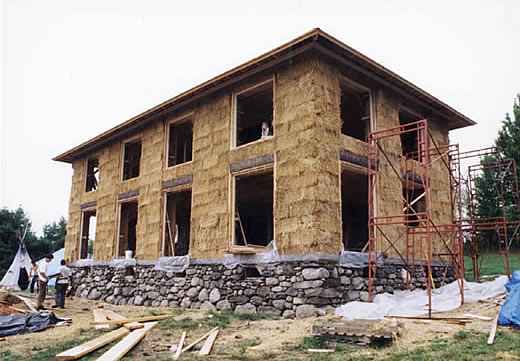 This type of agricultural waste is also a useful building material with many ideal properties for construction purpose. For ages, this is the kind of material used by our ancestor to roof the house. Some of the rural area in today society is still practicing this method.
Today, as the world is siding on green materials due to global warming and to promote sustainability, straw bales are becoming more and more popular in aim to reduce the load of environmental pollution.
It can be used to build houses, schools, even offices with straw walls that can be treated with additional elements like water-proof, fire-retardant, secure internal energy, resistance to thunderstorms, and ultimately friendly for the environment. This type building often has walls about 60 cm thick. It could be more expensive than the cost of cement and wood, but it is actually very cooling, and can save a lot of costs for heating in winter and regulating in during the summer.
Some design experts have determined that the use of rice straw as a building material is "ideal" in the policy of building "green buildings", because it does not only handle a quantity of waste in the agricultural sector but also contribute to saving energy for the whole society.
Compressed straw bales are extremely solid and sustainable construction materials. They are used as blocks for building structures, or as insulation. These thick straw walls have excellent thermal insulation properties, providing about 75% higher energy efficiency than traditional construction walls.
Contrary to your belief that straw houses are a fire hazard, they are capable of fighting fire twice as much as regular houses because straw bales are tightly packed without leaving. the place for oxygen to get in, so it is very hard to get burn.
This type of agricultural waste is also a useful building material with many ideal properties for construction purpose. For ages, this is the kind of material used by our ancestor to roof the house. Some of the rural area in today society is still practicing this method.
Today, as the world is siding on green materials due to global warming and to promote sustainability, straw bales are becoming more and more popular in aim to reduce the load of environmental pollution.
It can be used to build houses, schools, even offices with straw walls that can be treated with additional elements like water-proof, fire-retardant, secure internal energy, resistance to thunderstorms, and ultimately friendly for the environment. This type building often has walls about 60 cm thick. It could be more expensive than the cost of cement and wood, but it is actually very cooling, and can save a lot of costs for heating in winter and regulating in during the summer.
Some design experts have determined that the use of rice straw as a building material is "ideal" in the policy of building "green buildings", because it does not only handle a quantity of waste in the agricultural sector but also contribute to saving energy for the whole society.
Compressed straw bales are extremely solid and sustainable construction materials. They are used as blocks for building structures, or as insulation. These thick straw walls have excellent thermal insulation properties, providing about 75% higher energy efficiency than traditional construction walls.
Contrary to your belief that straw houses are a fire hazard, they are capable of fighting fire twice as much as regular houses because straw bales are tightly packed without leaving. the place for oxygen to get in, so it is very hard to get burn.
Excess Wood
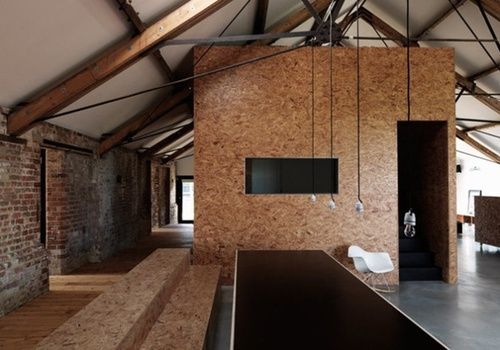 Excess logs can also be used as a construction material that is both unique and firm instead of only turning them into burning wood. You probably can get this material at sawmills, wood furniture manufacturing shops, or use dead trees. Logs are cut back into equal lengths, connected together by mortar, possibly made of cement, or clay.
This is a construction material with good thermal insulation and good heat absorption. The logs are insulated, keeping the indoor space warm; The mortar is able to absorb and heat the house. After a period of construction, wood can shrink or stretch and crack the mortar layer, but be assured because you can completely overcome this problem by plastering the mortar to the crack.
Currently a new method of application of wood chips in concrete is being researched and developed. Method of applying wood scraps such as sawdust and wood billet into construction, specifically making solid concrete and good waterproofing. It is expected to be a new step to reduce CO2 emissions and save natural resources. Surprisingly, this combination method unintentionally helps the material to stick better and be more durable, especially also better in waterproof.
Over the past year, wood factories in Singapore have generated more than half a million tons of wood waste, mainly sawdust. Most wood scraps are often recycled by decomposing into biochar, a porous coal made from organic materials. In some ways, biochar can bring environmental benefits. While most of the biomass fuel consumed in the last 10-20 years emits CO2 into the atmosphere, biochar is an amazingly stable material. They can even keep CO2 for thousands of years.
Excess logs can also be used as a construction material that is both unique and firm instead of only turning them into burning wood. You probably can get this material at sawmills, wood furniture manufacturing shops, or use dead trees. Logs are cut back into equal lengths, connected together by mortar, possibly made of cement, or clay.
This is a construction material with good thermal insulation and good heat absorption. The logs are insulated, keeping the indoor space warm; The mortar is able to absorb and heat the house. After a period of construction, wood can shrink or stretch and crack the mortar layer, but be assured because you can completely overcome this problem by plastering the mortar to the crack.
Currently a new method of application of wood chips in concrete is being researched and developed. Method of applying wood scraps such as sawdust and wood billet into construction, specifically making solid concrete and good waterproofing. It is expected to be a new step to reduce CO2 emissions and save natural resources. Surprisingly, this combination method unintentionally helps the material to stick better and be more durable, especially also better in waterproof.
Over the past year, wood factories in Singapore have generated more than half a million tons of wood waste, mainly sawdust. Most wood scraps are often recycled by decomposing into biochar, a porous coal made from organic materials. In some ways, biochar can bring environmental benefits. While most of the biomass fuel consumed in the last 10-20 years emits CO2 into the atmosphere, biochar is an amazingly stable material. They can even keep CO2 for thousands of years.
Soil
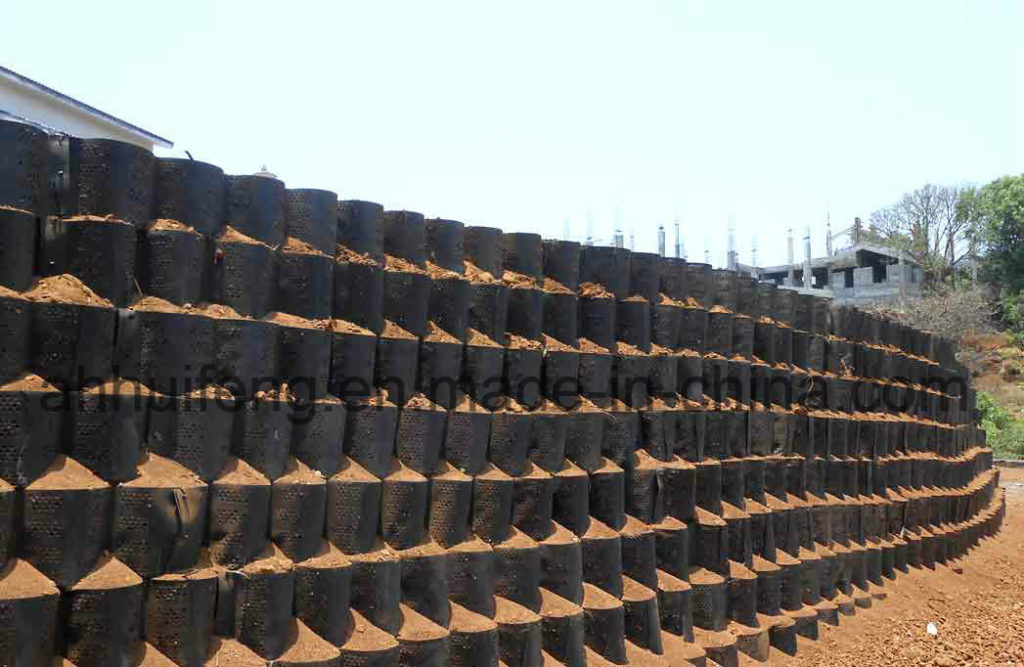 Although wood is the ideal material, it is not always available, and not everyone is able to afford this material. So the builders have devised a way to take advantage available right at the land at their feet.
Soil used to build walls is usually a mixture of some soils with high adhesion properties such as clay. When mixed at reasonable ratio and properly constructed, the earth walls will be very sustainable and able to withstand extreme weather.
Although it is a cheap material, it is also a highly effective material, and is a good absorbent and heat dissipation material. In addition, it also has other preeminent features such as anti-fire, anti-noise; In particular, it helps to limit deforestation and the use of other hazardous construction materials.
Although wood is the ideal material, it is not always available, and not everyone is able to afford this material. So the builders have devised a way to take advantage available right at the land at their feet.
Soil used to build walls is usually a mixture of some soils with high adhesion properties such as clay. When mixed at reasonable ratio and properly constructed, the earth walls will be very sustainable and able to withstand extreme weather.
Although it is a cheap material, it is also a highly effective material, and is a good absorbent and heat dissipation material. In addition, it also has other preeminent features such as anti-fire, anti-noise; In particular, it helps to limit deforestation and the use of other hazardous construction materials.
Bamboo
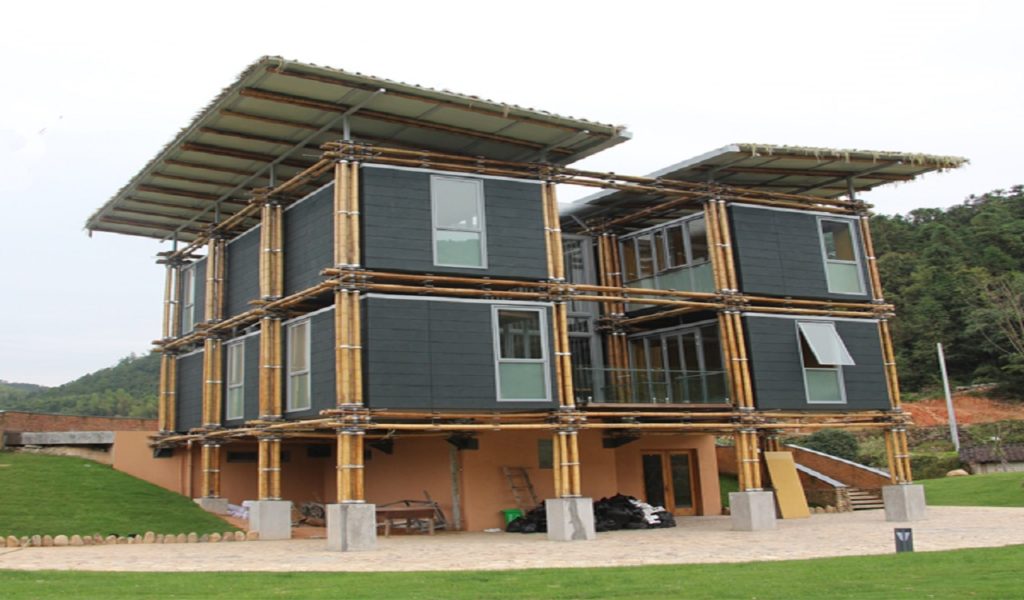 The use of bamboo as decorative material has long been very popular, and now, the trend of using bamboo flooring is very popular in the US. In Asia and South America, people often use wood to make houses, and bamboo is an extremely strong, healthy wood that people used to make highways and build bridges.
Bamboo is an abundant source of material and is ideal for construction and construction activities. Centuries ago, bamboo was the main source of construction materials. It is also a renewable source of materials because bamboo is one of the fastest growing species. Its life cycle is much shorter than other types of trees, and harvesting it does not affect the roots, so it can continue to multiply quickly.
To achieve the best use, bamboo must be treated with chemicals or soaked in mud to turn it into a water-proof and termite-resistant material. In addition, construction with this material requires different techniques and methods than conventional construction methods. However, this is an extremely flexible and flexible material, with extremely high durability.
The use of bamboo as decorative material has long been very popular, and now, the trend of using bamboo flooring is very popular in the US. In Asia and South America, people often use wood to make houses, and bamboo is an extremely strong, healthy wood that people used to make highways and build bridges.
Bamboo is an abundant source of material and is ideal for construction and construction activities. Centuries ago, bamboo was the main source of construction materials. It is also a renewable source of materials because bamboo is one of the fastest growing species. Its life cycle is much shorter than other types of trees, and harvesting it does not affect the roots, so it can continue to multiply quickly.
To achieve the best use, bamboo must be treated with chemicals or soaked in mud to turn it into a water-proof and termite-resistant material. In addition, construction with this material requires different techniques and methods than conventional construction methods. However, this is an extremely flexible and flexible material, with extremely high durability.
Read More About Other Eco-Friendly Building Materials:
- 10 Types of Green Building Materials That Are Better Than Concrete
- 15 Green Building Materials in Sustainable Construction
- Eco Friendly Construction Materials That Are Popular Globally




